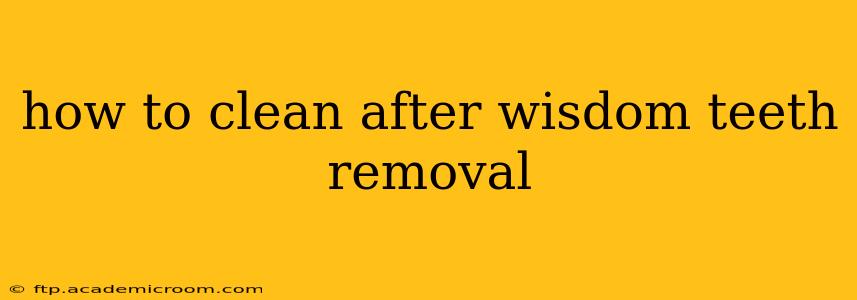Having your wisdom teeth removed is a significant oral surgery, and proper post-operative care is crucial for a speedy and complication-free recovery. This guide details how to clean your mouth effectively after wisdom teeth extraction, addressing common concerns and questions. Following these instructions meticulously will significantly reduce your risk of infection and promote optimal healing.
What are the initial steps after wisdom teeth removal?
Immediately after surgery, your surgeon will pack gauze into the extraction sites to help control bleeding. Bite down firmly on the gauze for at least 30-45 minutes, replacing it as needed. Avoid rinsing, spitting, or touching the extraction sites during this initial period. This allows blood clots to form, which are essential for healing. Following this initial period, gentle cleaning can begin.
How often should I rinse my mouth after wisdom teeth extraction?
Rinsing is vital, but it must be done gently. Start rinsing with saltwater (1/4 to 1/2 teaspoon of salt dissolved in 8 ounces of warm water) every 2-3 hours after the initial bleeding has subsided. Avoid vigorous rinsing or swishing, as this could dislodge the blood clots. Instead, gently swish the saltwater around your mouth, letting it flow over the extraction sites. This helps clean away food debris and bacteria, preventing infection. Continue this gentle rinsing for at least a week, or as advised by your oral surgeon.
What kind of toothbrush should I use after wisdom teeth removal?
Use a soft-bristled toothbrush to avoid irritating the healing gums. Be very gentle when brushing around the extraction sites, focusing on the surrounding teeth. Avoid brushing directly on the extraction sockets.
What should I avoid eating after wisdom teeth removal?
For the first few days, stick to a liquid or soft food diet. Avoid foods that require chewing, such as nuts, seeds, crunchy chips, or tough meats. Straws should also be avoided, as the sucking action can dislodge blood clots. Opt for nutritious options like smoothies, soups, yogurt, applesauce, and mashed potatoes.
Can I use mouthwash after wisdom teeth removal?
Your surgeon may recommend a specific mouthwash, but generally, avoid using alcohol-based mouthwashes as they can irritate the healing tissues. The saltwater rinse is usually sufficient, but if your surgeon recommends a specific mouthwash, follow their instructions carefully.
When can I resume my normal oral hygiene routine?
You can gradually resume your normal brushing and flossing routine after the initial healing period (typically a week or so), but always remain gentle around the extraction sites. Your surgeon will provide specific guidelines tailored to your situation.
What are the signs of a dry socket?
A dry socket is a painful complication that occurs when the blood clot is dislodged from the extraction site. Signs include severe pain, a bad taste in your mouth, and a visible empty socket. If you experience these symptoms, contact your oral surgeon immediately.
When should I call my dentist or oral surgeon?
Contact your oral surgeon immediately if you experience:
- Excessive bleeding that doesn't stop after biting down on gauze.
- Severe pain that isn't relieved by over-the-counter pain medication.
- Signs of infection, such as swelling, redness, fever, or pus.
- Difficulty swallowing or breathing.
- Dry socket symptoms.
By following these guidelines and diligently caring for your mouth, you can contribute significantly to a smooth and successful recovery after your wisdom teeth removal. Remember, consistent communication with your oral surgeon is key to ensuring optimal healing and addressing any concerns that might arise. Always prioritize their advice and instructions, as they are best equipped to guide your specific post-operative care.
